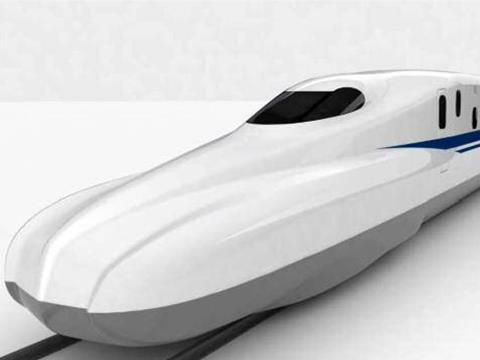
JAPAN: JR Central is to build a 16-car pre-series trainset as a testbed for various technical changes to be incorporated in the next generation of trains for the Tokaido and Sanyo Shinkansen, the railway announced on June 24. The Series N700S is due to be completed in March 2018, while the series-built trains would enter commercial service from 2021.
Following the current fleet of N700 and N700A trainsets, the S suffix represents ‘Supreme’. JR Central says the trains are intended to be ‘the best of the N700 series’.
Three main technical changes are envisaged. Modifications to the braking system and automatic train control are intended to shorten the emergency braking distance in the event of an earthquake. Based on research undertaken at JR Central’s own R&D centre, there will be improvements to the bogie vibration sensors, which will be coupled with changes to the active suspensions to improve ride quality.
Silicon carbide semiconductors will be incorporated into the traction control system to reduce weight and minimise energy consumption. According to JR Central, these are more resistant to high temperatures, and will be combined with air cooling technology developed in house.
To enhance environmental performance, the N700S driving cars will have a new nose profile designated as ‘Dual Supreme Wing Type’. This has been developed using 3D simulation to reduce the sonic boom when running through tunnels. Air resistance will be minimised by modifying the car shape and smoothing the external surfaces. JR Central estimates that the new profile, lighter vehicles and the adoption of SiC semiconductors will together reduce energy consumption by around 7% compared to the Series N700A.
The other main change with the N700S will be the use of more standardised car designs, reducing the number of vehicle types to four, with a rearrangement of the underfloor traction and auxiliary equipment. This would make it simpler to marshal 16, 12 and 8-car formations as traffic dictates. JR Central believes that the use of standard cars will enable it to introduce ‘higher quality’ trains at a lower cost, with shorter delivery times for both the domestic and international markets. This could include the Texas Central project between Dallas and Houston, where a JR Central affiliate company is providing technical support.
The on-train monitoring systems are to be enhanced, with a higher capacity link for transmitting information to a Data Analysis Centre at the main depot. This will allow the railway to monitor performance and system reliability in real time, and support a move to condition-based maintenance. On-board CCTV will enable the control centres to monitor security in real time, particularly in the event of any emergency.
Passenger comfort improvements include the installation of ‘Full Active Vibration Control’ on the Green Car vehicles. Electric outlets for mobile phones, which are already installed on all Green Car seats in the N700A sets, will be provided at all seats on the N700S. Li-ion batteries will be provided to power the toilets if the main supply is lost, ‘improving the passengers’ convenience at an unusual time’.

















